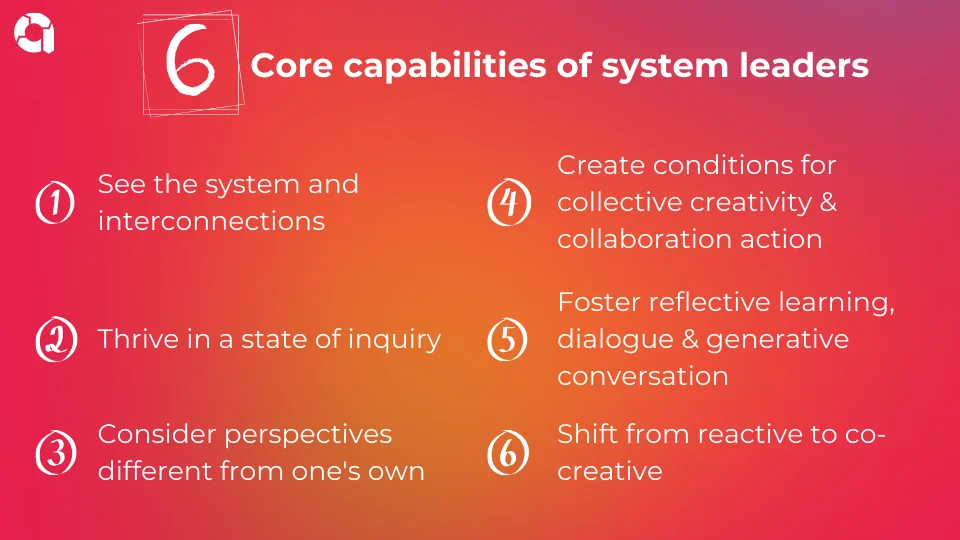In today’s rapidly changing and complex world, traditional leadership, approaches are no longer sufficient to tackle the challenges faced by individuals, organizations, and society. In this context, systems leadership has emerged as a new and innovative approach that recognizes the complex, interconnected, and dynamic nature of modern challenges. Systems leadership offers a way to not only cope with but also thrive in the face of complexity and uncertainty by enabling leaders to engage in dynamic and collaborative processes of change and innovation.
In this article, we delve into the idea of system leadership. We explain the importance of having system leadership, the required skills for it and how systems thinking can enhance the effectiveness of system leadership
The need for systems leadership
Complexity changes the nature of leading. Traditionally, leadership has been viewed as a hierarchical and linear process that involves command and control. However, as the world is becoming more complex and interconnected, no single person or institution can provide all the solutions to the challenges we face. Systems leadership recognizes the need for a different perspective on leadership, one that acknowledges that leading in complex systems requires a different mindset, skillset, and toolset than traditional leadership approaches (Senge, Hamilton, & Kania, 2014).
Systems leadership involves a systemic approach to cultivating leadership capacity across multiple levels and domains. It emphasizes the development of collective sense-making, collaboration, and co-creation among diverse stakeholders. Rather than focusing solely on individual leaders, systems leadership involves empowering networks, communities, and teams to engage in adaptive processes of learning, experimentation, and innovation.
Leaders struggle when faced with uncertainty, continuous change, and wicked problems. One of the biggest challenges of leading in complex systems is the uncertainty and ambiguity that comes with it. Complexity often involves non-linear, unpredictable, and emergent patterns of behaviour that require leaders to be agile, adaptable, and innovative. Moreover, wicked problems such as climate change, digital divide, healthcare access/affordability, poverty, and inequality require leaders to adopt a collective and systemic mindset that goes beyond the traditional sectoral and disciplinary boundaries.
Systems leadership is about creating transformative change for the greater good of society. It involves cultivating a shared purpose, vision, and values that go beyond self-interests and short-term gains. Systems leaders view themselves as part of a larger ecosystem that includes multiple stakeholders with diverse needs and perspectives. They strive to create conditions for collective creativity, innovation, and action that benefit all members of the system.
Also Read : Unmasking the hidden dangers and discovering strategies for collaborative success in today’s world
Core capabilities of system leaders
Nancy Southern provides an insightful analysis in her paper titled “Creating Leaders for Systems Complexity”(Southern,2021). In this paper, she builds upon Peter Senge’s three fundamental capabilities of systems leaders, including the ability to see the system, to foster reflection and generative conversation and creating a shift in the nature of problem solving from reactive to co-reactive. She further expands and offers a set of following six capabilities listed in figure 1:

-
See the system and its interconnections
In order to effectively tackle complex problems, it is essential to develop a systems lens that allows leaders to focus on interrelationships and dynamics within the system. It’s important to recognize that government, private and non-profit organizations are complex systems with embedded structures and patterns of behavior that impact decision-making and outcomes. Transformational changes, while useful, often address only parts of the problem without addressing the system as a whole. Additionally, there isn’t always a direct cause-and-effect relationship in systems. This is where a systems lens provides a shift from a reductionist view to a synthetic, expansionist, dynamic, and multiple/mutual causality approach. By adopting a systems lens, leaders can recognize the patterns of relationships within the context of wholes and ultimately build a shared understanding that is necessary for lasting and impactful solutions.
-
Thrive in a state of inquiry
Successful system leaders are curious, ask questions, and search for answers to gain a better grasp of complex situations. Systems inquiry establishes a praxis where theory guides practical application, and the insights gained from practical application, in turn, shape theory, thus fostering a progressive cycle of inquiry, learning, and transformative change. Systems leaders are critical thinkers who challenge underlying assumptions, question the status quo and always try to identify opportunities for improvement and innovation. Systems leaders who embrace inquiry are able to navigate through ambiguity and make informed decisions that drive positive change.
-
Consider perspectives different from one’s own
It has been observed that collective thought is more powerful than individual thought. As a result, promoting dialogue has been seen as an effective approach to exploring how our minds engage with thoughts and challenging assumptions. This approach is aimed at suspending individual biases and cultivating cultural humility while embracing disagreements to encourage diverse perspectives. It is crucial to note that disagreements should not be avoided, but rather leveraged to prevent groupthink and enhance decision-making processes. Leaders, in particular, must create environments that foster the engagement of different perspectives, including disagreements, to tackle systemic challenges and arrive at effective decisions.
-
Create conditions for collective creativity and collaborative action
To achieve collective creativity, both individual and collective learning are essential. Team learning focuses on developing the team’s capacity to generate desired outcomes through shared vision, personal mastery, and mental models. When systems thinking is integrated into this collective learning process, it facilitates collaboration, innovation, and continuous learning. This process supports organizations in creating their desired future while developing the skillset required to learn and adapt quickly. Leaders who want to promote organizational learning must shift from a hero to a catalyst and enabler role. This includes modeling behaviors that encourage engagement and establishing a learning infrastructure to support distributed and shared leadership. By adopting these key components, businesses and teams can cultivate a culture of learning that fosters collective creativity and long-term success.
-
Foster reflective learning, dialogue, and generative conversation
Leadership requires more than just effective decision-making and management skills. It demands a capacity for reflective learning. Reflection in action involves the ability to analyze one’s own thoughts and actions, identifying implicit biases and assumptions. This skill enables leaders to challenge existing assumptions, reframe problems, and ultimately improve their effectiveness. However, reflection is not a solo endeavour, but rather a collaborative practice. Through dialogue, leaders can engage in a deliberate process of reflective practice and improved communication. Generative dialogue, in particular, allows for the exploration of new perspectives, the abandonment of outdated assumptions, and renewed energy for the task at hand. To be effective leaders, it is essential to create conditions for intentional, dialogic processes that support systemic thinking and collaborative engagement.
-
Shift the nature of problem-solving from reactive to co-creative
Leaders play a crucial role in addressing complex problems, but it is impossible for them to solve systemic issues alone. They need diverse perspectives and shared leadership to create the conditions for meaningful change. Systemic problems often arise from gaps and failures in multiple aspects, making it important for leaders to appreciate complexity, act locally, establish boundaries, and engage with multiple perspectives. The ethical decision of defining boundaries shapes the focus and nature of inquiry. Co-creative interventions that engage different perspectives and challenge assumptions can lead to critical thinking and dialogue. Leaders can develop sustained interactions and co-create new patterns of behaviour by leveraging diverse perspectives rather than solely focusing on individuals.

Transform Your Thinking
Join our Systems Thinking certification to unlock innovative solutions for complex challenges.
How systems thinking can help become a better systems leader?
Systems thinking draws on the foundation of concepts, principles, and models that have evolved over time. It provides us with paradigms, strategies, approaches, methods, and tools for analyzing, designing and managing complex systems (Midgley, 2021).
Systems thinking offers valuable tools and perspectives for individuals seeking to enhance their abilities as systems leaders. By embracing this approach, leaders can gain a deeper understanding of complex systems and develop strategies to address potential risks. They learn to examine the underlying assumptions that shape their thinking and challenge existing mental models that may limit their effectiveness. Systems thinking empowers leaders to make more informed and effective strategic choices by considering the dynamic behaviors of physical and social flows and processes and understanding their causal relationships. Furthermore, leaders are encouraged to explore diverse worldviews relevant to real-world situations, engaging in debates that foster critical thinking and enable the contrasting of different perspectives. Systems thinking also emphasizes the importance of visionary design, allowing leaders to envision how organizations should be and plan effective strategies for implementation. The use of specified boundary questions ensures that the decisions made by planners and designers can be challenged, promoting a more inclusive and collaborative approach. Moreover, systems thinking enables leaders to diagnose and design organizations effectively, considering a range of strategic options and ultimately achieving consensus through constructive dialogue and the exchange of ideas.
By incorporating various systems thinking concepts and approaches, leaders can drive innovation, improve organizational effectiveness, and successfully navigate the ever-evolving business landscape.
Also Read : The crucial role of emergence in systems thinking
Conclusion
In sum, systems leadership is an innovative and transformative approach to leading in complex systems. It requires a shift from control-based leadership to dynamic engagement with others. Systems leaders recognize that they cannot solve complex problems alone and therefore engage in collective and systemic processes of change. They cultivate leadership capacity across networks, teams, and communities and work towards a shared purpose, vision, and values that create the conditions for transformative change. As such, systems leadership offers a way to tackle the challenges we face today and build sustainable and inclusive systems for the future.


